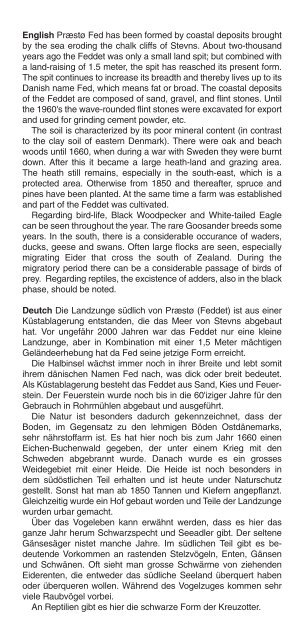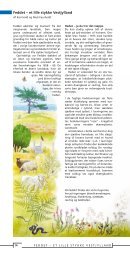Ture: Feddet - Strandgård - Musik over Præstø fjord
Ture: Feddet - Strandgård - Musik over Præstø fjord
Ture: Feddet - Strandgård - Musik over Præstø fjord
You also want an ePaper? Increase the reach of your titles
YUMPU automatically turns print PDFs into web optimized ePapers that Google loves.
English <strong>Præstø</strong> Fed has been formed by coastal deposits brought<br />
by the sea eroding the chalk cliffs of Stevns. About two-thousand<br />
years ago the <strong>Feddet</strong> was only a small land spit; but combined with<br />
a land-raising of 1.5 meter, the spit has reasched its present form.<br />
The spit continues to increase its breadth and thereby lives up to its<br />
Danish name Fed, which means fat or broad. The coastal deposits<br />
of the <strong>Feddet</strong> are composed of sand, gravel, and flint stones. Until<br />
the 1960's the wave-rounded flint stones were excavated for export<br />
and used for grinding cement powder, etc.<br />
The soil is characterized by its poor mineral content (in contrast<br />
to the clay soil of eastern Denmark). There were oak and beach<br />
woods until 1660, when during a war with Sweden they were burnt<br />
down. After this it became a large heath-land and grazing area.<br />
The heath still remains, especially in the south-east, which is a<br />
protected area. Otherwise from 1850 and thereafter, spruce and<br />
pines have been planted. At the same time a farm was established<br />
and part of the <strong>Feddet</strong> was cultivated.<br />
Regarding bird-life, Black Woodpecker and White-tailed Eagle<br />
can be seen throughout the year. The rare Goosander breeds some<br />
years. In the south, there is a considerable occurance of waders,<br />
ducks, geese and swans. Often large flocks are seen, especially<br />
migrating Eider that cross the south of Zealand. During the<br />
migratory period there can be a considerable passage of birds of<br />
prey. Regarding reptiles, the excistence of adders, also in the black<br />
phase, should be noted.<br />
Deutch Die Landzunge südlich von <strong>Præstø</strong> (<strong>Feddet</strong>) ist aus einer<br />
Küstablagerung entstanden, die das Meer von Stevns abgebaut<br />
hat. Vor ungefähr 2000 Jahren war das <strong>Feddet</strong> nur eine kleine<br />
Landzunge, aber in Kombination mit einer 1,5 Meter mächtigen<br />
Geländeerhebung hat da Fed seine jetzige Form erreicht.<br />
Die Halbinsel wächst immer noch in ihrer Breite und lebt somit<br />
ihrem dänischen Namen Fed nach, was dick oder breit bedeutet.<br />
Als Küstablagerung besteht das <strong>Feddet</strong> aus Sand, Kies und Feuerstein.<br />
Der Feuerstein wurde noch bis in die 60'iziger Jahre für den<br />
Gebrauch in Rohrmühlen abgebaut und ausgeführt.<br />
Die Natur ist besonders dadurch gekennzeichnet, dass der<br />
Boden, im Gegensatz zu den lehmigen Böden Ostdänemarks,<br />
sehr nährstoffarm ist. Es hat hier noch bis zum Jahr 1660 einen<br />
Eichen-Buchenwald gegeben, der unter einem Krieg mit den<br />
Schweden abgebrannt wurde. Danach wurde es ein grosses<br />
Weidegebiet mit einer Heide. Die Heide ist noch besonders in<br />
dem südöstlichen Teil erhalten und ist heute under Naturschutz<br />
gestellt. Sonst hat man ab 1850 Tannen und Kiefern angepflanzt.<br />
Gleichzeitig wurde ein Hof gebaut worden und Teile der Landzunge<br />
wurden urbar gemacht.<br />
Über das Vogeleben kann erwähnt werden, dass es hier das<br />
ganze Jahr herum Schwarzspecht und Seeadler gibt. Der seltene<br />
Gänsesäger nistet manche Jahre. Im südlichen Teil gibt es bedeutende<br />
Vorkommen an rastenden Stelzvögeln, Enten, Gänsen<br />
und Schwänen. Oft sieht man grosse Schwärme von ziehenden<br />
Eiderenten, die entweder das südliche Seeland überquert haben<br />
oder überqueren wollen. Während des Vogelzuges kommen sehr<br />
viele Raubvögel vorbei.<br />
An Reptilien gibt es hier die schwarze Form der Kreuzotter.



